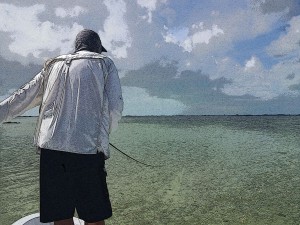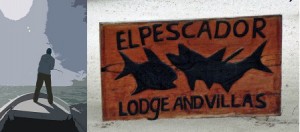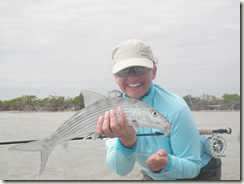The final installment of my Grand Slam Reflections. The Getting There. The Permit. The Bonefish.
The Tarpon
We had been at the point of the caye for a while when Katchu looked at his watch and said “If we want to get your Grand Slam, we better go now.”
It was then I realized that this might actually happen. It had been running through the back of my mind since I got the permit. I had two of three in the books, so it was conceivable at the very least, but it still sounded a tad ridiculous. We got back in the boat and headed off in search of tarpon.
Five minutes after getting back in the boat we found ourselves weaving along an ancient mangrove lined canal carved by the Mayans thousands of years ago. To our left was Mexico, to our right was Belize. Bait and boils were everywhere… this was clearly a very fishy place. There is something amazingly cool about going through mangrove lined channels in a boat in pursuit of fish.

We reached a small, enclosed lagoon and Katchu killed the engine and poled us into position. I got up on deck needing only a tarpon to complete the Grand Slam. We were going after ‘baby tarpon” which was a good thing since I had royally botched my first ever adult tarpon grab the day before. I was 0/1 for tarpon in my life.
Shane spotted a tarpon heading into the mangroves. There was no cast to make. We waited. Out of the mangroves and 40 feet from the boat emerged five “baby” tarpon. These fish were 30-60 pounds. I suddenly felt very unprepared.
I made the cast and gave some strips to the black cockroach. One of the tarpon attacked it. It just swam up to it and opened its gaping mouth and inhaled the fly. When you haven’t done this a lot a tarpon eat can make you instantly stupid. I set, still in disbelief and a bit awestruck. It felt a little more believable when I then raised the rod tip and the fly parted ways with the tarpon. I was now 0/2.
Despite just botching the job, the fish were still there and it looked like they wanted to eat. I cast again. I stripped again. The damn fish charged the fly and ate it hard. I set (at least twice), I kept the rod down. This fly wasn’t coming out. The fish, however, decided to split and charged into the mangroves. The fish was out of sight, but I was still attached to it. As I stood there, a little dumbfounded, the tarpon shot back out into the lagoon ten feet from where it had disappeared. It jumped about 5 feet in the air, still attached to the fly line which was now hopelessly wrapped around the mangroves. When the fish jumped I got a really good view of how big it really was and I’d put it at about 40 pounds of pure silver fury. The tarpon splashed down and zipped right back into the mangroves to complete a nice wrap around several mangrove limbs and, predictably, the tugging stopped. I was off the fish and had to break off the fly. I was now 0/3 on tarpon.
While I was re-rigging Shane got on deck. These baby tarpon were in a very playful mood and it wasn’t long before Shane had fish to cast to. He made the cast and the fish smashed it. This baby tarpon was around forty pounds and, just like the permit earlier in the day, the tarpon spit the hook. If it were another day, Shane would have stayed on the deck, but this had turned from a normal day to a possible Grand Slam Day. I was going to be up again.
My hands still trembling, I continued to re-rig as we entered a narrow, nearly fully enclosed mangrove chute. This was a one shot stop as the chute dead-ended just 50 feet in front of us. Katchu knew these waters very well and as we entered the small clearing we found a single tarpon milling about. With mangroves behind and to the right of me I had to cast off shoulder, but somehow I made the cast. I stripped the fly. The fish saw it. He charged. I kept stripping. He ate as I had just finished a long strip and I had no way to move the fly but to sweep the rod tip. I was now 0/4 as the fly came out of the fishes mouth.
I stood there shell-shocked, having just missed the third tarpon that would have given me a Grand Slam. The fish, however, was still interested. While I had pulled the fly away from the fish, the fly was still in the water and near the fish. I stripped. He ate. I set. I set again. I set again. I didn’t raise the rod tip. I didn’t let the fish run into the mangroves. I held the line hard with my stripping hand and the 15 pound class tippet held to the 60 pound shock tippet. The fish jumped. Now… I’m 6’3” and was probably at least 2 feet above the water on the casting deck. The fish jumped over my head, an image that will forever be seared into my memory. Somehow, deep in my brain, a couple of cells fired and I reactivity bowed to the king. The fish stayed on.
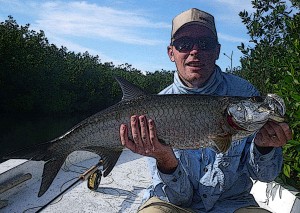
Quickly the fish was in. I had just completed an Inshore Grand Slam by landing my first tarpon ever on the heals of landing my first ever permit.
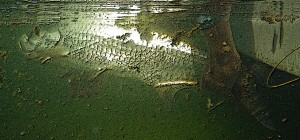

For a job well done.
A special thanks to El Pescador for hosting Shane and I for three days of fantastic fishing and story making. You guys have a first class operation there.
— paid ad below —
Learn everything about boating safety at BoaterExam.com


